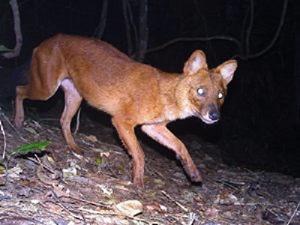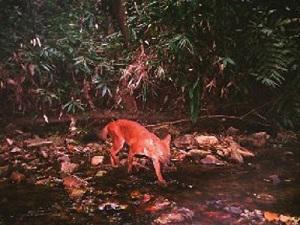Jan F. Kamler
The aim of the project is to have a better understanding on how reserve zonation affects the ecology and conservation of endangered large carnivores, this project will examine the density, pack size, diet and prey selection of dholes across the core, buffer, and unprotected zones in one of the largest protected area in Lao PDR.

Recent camera trap photo of a dhole in Nam Et-Phou Louey, northern Laos
Dholes (Cuon alpinus) have disappeared from >80% of their distribution during the past 50 years, and remaining populations occur in small, isolated populations in India and Southeast Asia. Dholes require more land area for long-term persistence than any other large carnivore in Asia, and consequently have disappeared from more reserves than have tigers. Despite their seemingly dire fate, research has yet to determine how reserve size and design affects dhole numbers and distribution. Such information is vital for dhole conservation efforts throughout Asia.

The dhole in Nam Et-Phou Louey - camera trap photo from WCS Lao PDR NEPL NPA
Located in a biodiversity hotspot, Lao PDR contains 17 protected areas covering 13% of the country. One of the largest reserves is the Nam Et-Phou Louey (NEPL) National Protected Area (5,950 km2), which includes a 3,000 km2 core area where human access and wildlife harvest is prohibited, and a 2,950 km2 buffer area where pre-existing villages are allocated land for subsistence living. The overall goal of NEPL is to function as a model for landscape management and wildlife conservation in Asia.
The primary aim of this project is to determine how the different management zones of NEPL affect dhole ecology, and if this reserve design can effectively conserve dholes. The major achievements will be to determine the density of dholes and their prey in different management zones of NEPL. This project also will determine pack size and prey selection of dholes across the different management zones. We will use only non-invasive techniques (e.g., DNA analysis of faeces) to collect basic ecological data on dholes and their prey. Because little is known about the dhole ecology in Southeast Asia, our results will have global importance for dhole conservation efforts, as well as having practical recommendations for management of the local dhole population within NEPL. A special focus will be placed on investigating and resolving livestock predation by dholes, which must be reduced if dholes are to be conserved into the future. Other major achievements include the training of students and park staff for identification of dhole and prey signs, and the initiation of long-term surveys for dholes.